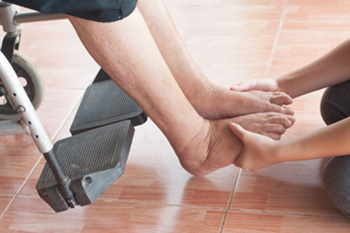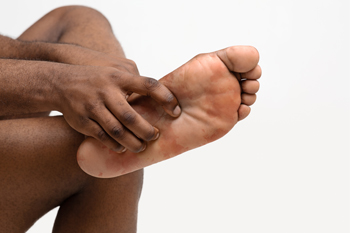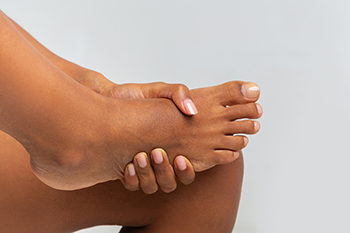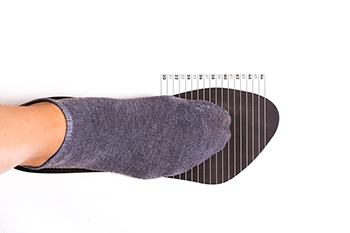Dallas Metro / North Texas
(214) 710-1028
December 2023
Elderly Foot and Ankle Problems

Foot and ankle problems are prevalent medical issues, particularly among the elderly, who often suffer from pain, stiffness, swelling, or deformities. Common diagnoses include conditions such as corns, athlete's foot, bunions, flat feet, ingrown nails, and warts. Aging-related muscle mass and loss of bone strength may increase seniors' risk for injuries and fractures, compounded by balance and vision issues. Key foot and ankle injuries in the elderly include ankle sprains, where the ligaments are overstretched or torn, potentially weakening the ankle and leading to arthritis, if untreated. Achilles tendonitis and tears are also common. The Achilles is vulnerable to inflammation and overuse, which can escalate to tears or ruptures, especially with sudden trauma. Ankle fractures are serious injuries from traumatic impact, requiring immediate podiatric attention to prevent complications such as infections. The spectrum of foot and ankle injuries in the elderly ranges from minor, treatable conditions to severe injuries necessitating medical intervention, highlighting the need for attentive care to prevent these issues. If you are elderly and have foot or ankle problems, it is suggested that you make an appointment with a podiatrist for a proper diagnosis and treatment.
Ankle pain can be caused by a number of problems and may be potentially serious. If you have ankle pain, consult with Kellvan Cheng, DPM from Elite Foot & Ankle. Our doctor will assess your condition and provide you with quality foot and ankle treatment.
Ankle pain is any condition that causes pain in the ankle. Due to the fact that the ankle consists of tendons, muscles, bones, and ligaments, ankle pain can come from a number of different conditions.
Causes
The most common causes of ankle pain include:
- Types of arthritis (rheumatoid, osteoarthritis, and gout)
- Ankle sprains
- Broken ankles
- Achilles tendonitis
- Achilles tendon rupture
- Stress fractures
- Bursitis
- Tarsal tunnel syndrome
- Plantar fasciitis
Symptoms
Symptoms of ankle injury vary based upon the condition. Pain may include general pain and discomfort, swelling, aching, redness, bruising, burning or stabbing sensations, and/or loss of sensation.
Diagnosis
Due to the wide variety of potential causes of ankle pain, podiatrists will utilize a number of different methods to properly diagnose ankle pain. This can include asking for personal and family medical histories and of any recent injuries. Further diagnosis may include sensation tests, a physical examination, and potentially x-rays or other imaging tests.
Treatment
Just as the range of causes varies widely, so do treatments. Some more common treatments are rest, ice packs, keeping pressure off the foot, orthotics and braces, medication for inflammation and pain, and surgery.
If you have any questions, please feel free to contact our office located in Carrollton, TX . We offer the newest diagnostic and treatment technologies for all your foot care needs.
What is Plantar Fasciosis?

Pain on the bottom of the foot, particularly in the heel area, may be caused by plantar fasciosis, a condition often mistaken for plantar fasciitis. Unlike the latter, plantar fasciosis is characterized by repetitive stress on the plantar fascia rather than inflammation. Plantar fasciosis can develop due to a sedentary lifestyle, wearing high-heeled shoes, or having abnormal foot arches. Tight calf muscles or Achilles tendons also may contribute, and for that reason plantar fasciosis is common among runners, dancers, and anyone with poor foot posture. A sudden increase in activity or a shift to wearing less supportive footwear such as sandals, are other causes. The main symptom of plantar fasciosis is intense heel pain, particularly when first bearing weight in the morning or after periods of rest. A proper diagnosis involves a thorough examination of the foot and may include imaging tests. Understanding the difference between plantar fasciosis and plantar fasciitis is key to effective management of this type of pain. If you are grappling with persistent heel pain, it is suggested that you schedule an appointment with a podiatrist for a diagnosis and the appropriate treatment options.
Many people suffer from bouts of heel pain. For more information, contact Kellvan Cheng, DPM of Elite Foot & Ankle. Our doctor can provide the care you need to keep you pain-free and on your feet.
Causes of Heel Pain
Heel pain is often associated with plantar fasciitis. The plantar fascia is a band of tissues that extends along the bottom of the foot. A rip or tear in this ligament can cause inflammation of the tissue.
Achilles tendonitis is another cause of heel pain. Inflammation of the Achilles tendon will cause pain from fractures and muscle tearing. Lack of flexibility is also another symptom.
Heel spurs are another cause of pain. When the tissues of the plantar fascia undergo a great deal of stress, it can lead to ligament separation from the heel bone, causing heel spurs.
Why Might Heel Pain Occur?
- Wearing ill-fitting shoes
- Wearing non-supportive shoes
- Weight change
- Excessive running
Treatments
Heel pain should be treated as soon as possible for immediate results. Keeping your feet in a stress-free environment will help. If you suffer from Achilles tendonitis or plantar fasciitis, applying ice will reduce the swelling. Stretching before an exercise like running will help the muscles. Using all these tips will help make heel pain a condition of the past.
If you have any questions please contact our office located in Carrollton, TX . We offer the newest diagnostic and treatment technologies for all your foot and ankle needs.
Dealing With Foot Pain

Foot pain can stem from a myriad of causes, each intricately tied to the complex structure of the foot. One prevalent contributor is improper footwear, as shoes with an ill fit or high heels can induce foot pain and disorders. The foot, supporting the body's weight, is susceptible to injuries during high-impact activities like running or aerobics. These activities can lead to ligament sprains, muscle or tendon strains, and foot bone fractures. Degenerative conditions such as osteoarthritis and rheumatoid arthritis may also play a role in foot pain. Osteoarthritis arises from cartilage overuse around joints, commonly affecting the big toe, ankle, and midfoot. Meanwhile, rheumatoid arthritis introduces pain, stiffness, swelling, soreness, and warmth in the foot and ankle joints. Diabetes, with its repercussions like nerve damage, reduced blood flow, and ulcers, often contributes significantly to foot pain. Numerous other conditions further complicate foot health, including plantar fasciitis and Achilles’ tendonitis. Corns, calluses, bunions, and plantar warts are other sources of foot pain. Ingrown toenails, Morton’s neuroma, and hammertoes may induce pain in parts of the foot. Peripheral arterial disease, gout, and flat feet are still other conditions that generate foot pain. If you experience any type of foot pain that persists or gets worse, it is suggested that you make an appointment with a podiatrist.
Foot Pain
Foot pain can be extremely painful and debilitating. If you have a foot pain, consult with Kellvan Cheng, DPM from Elite Foot & Ankle. Our doctor will assess your condition and provide you with quality foot and ankle treatment.
Causes
Foot pain is a very broad condition that could be caused by one or more ailments. The most common include:
- Bunions
- Hammertoes
- Plantar Fasciitis
- Bone Spurs
- Corns
- Tarsal Tunnel Syndrome
- Ingrown Toenails
- Arthritis (such as Gout, Rheumatoid, and Osteoarthritis)
- Flat Feet
- Injury (from stress fractures, broken toe, foot, ankle, Achilles tendon ruptures, and sprains)
- And more
Diagnosis
To figure out the cause of foot pain, podiatrists utilize several different methods. This can range from simple visual inspections and sensation tests to X-rays and MRI scans. Prior medical history, family medical history, and any recent physical traumatic events will all be taken into consideration for a proper diagnosis.
Treatment
Treatment depends upon the cause of the foot pain. Whether it is resting, staying off the foot, or having surgery; podiatrists have a number of treatment options available for foot pain.
If you have any questions, please feel free to contact our office located in Carrollton, TX . We offer the newest diagnostic and treatment technologies for all your foot care needs.
Shoe Types and Proper Fitting

Podiatrists play a vital role in advising on shoe types and ensuring proper fitting, which is essential for foot health and comfort. They begin by evaluating the individual's foot shape, size, arch type, and any specific foot conditions, such as flat feet or high arches. Understanding these characteristics allows them to recommend shoes that provide the right support and fit. Podiatrists often suggest footwear with adequate cushioning, arch support, and a proper toe box size to accommodate the foot comfortably without causing pressure. For those with specific foot problems or unique biomechanical needs, podiatrists may recommend custom-made orthotic inserts. These inserts are designed to fit perfectly within the shoe, providing additional support and aligning the foot correctly to reduce strain and prevent injuries. Podiatrists also educate on the importance of replacing shoes regularly, especially for active individuals, as worn-out shoes can lead to poor foot alignment and increased injury risk. If you would like counsel on selecting the right shoe and size for you or your family members, it is suggested that you make an appointment with a podiatrist for this type of guidance.
Getting the right shoe size is an important part of proper foot health. Seek the assistance of Kellvan Cheng, DPM from Elite Foot & Ankle. Our doctor will provide the care you need to keep you pain-free and on your feet.
Getting the Right Shoe Size
There are many people who wear shoes that are the incorrect size, negatively affecting their feet and posture. Selecting the right shoes is not a difficult process, so long as you keep several things in mind when it comes to choosing the right pair.
- When visiting the shoe store, use the tools available to measure your foot.
- Be sure there is ‘wiggle room’. There should be about an inch between your toes and the tip of your shoes.
- Do not always assume you are the same size, as manufacturers run differently.
- Purchase shoes later in the day, as your feet swell as the day progresses.
- If a shoe is not comfortable, it is not suitable. Most shoes can’t be ‘broken in’, and comfort should be the ultimate goal when it comes to choosing the right pair of shoes
As our feet hold our body weight and keep us moving, it is important to treat them right. Picking the right pair of shoes can provide your feet comfort and mobility without pain.
If you have any questions, please feel free to contact our office located in Carrollton, TX . We offer the newest diagnostic and treatment technologies for all your foot care needs.
Gout Pain Can Be Managed
Blog Archives
- July 2025
- June 2025
- May 2025
- April 2025
- March 2025
- February 2025
- January 2025
- December 2024
- November 2024
- October 2024
- September 2024
- August 2024
- July 2024
- June 2024
- May 2024
- April 2024
- March 2024
- February 2024
- January 2024
- December 2023
- November 2023
- October 2023
- September 2023
- August 2023
- July 2023
- June 2023
- May 2023
- April 2023
- March 2023
- February 2023
- January 2023
- December 2022
- November 2022
- October 2022
- September 2022
- August 2022
- July 2022
- June 2022
- May 2022
- April 2022
- March 2022
- February 2022
- January 2022
- December 2021
- November 2021
- October 2021
- September 2021
- August 2021
- July 2021
- June 2021
- May 2021
- April 2021
- March 2021
- April 2020
- March 2020
- February 2020
- January 2020
- December 2019
- November 2019
- October 2019
- September 2019
- August 2019
- July 2019
- June 2019
- May 2019
- April 2019
- March 2019
- February 2019
- January 2019
- December 2018
- November 2018
- October 2018
- September 2018
- August 2018
- July 2018
- June 2018
- May 2018
- April 2018
- March 2018
- February 2018
- January 2018
- December 2017
- November 2017
- October 2017





